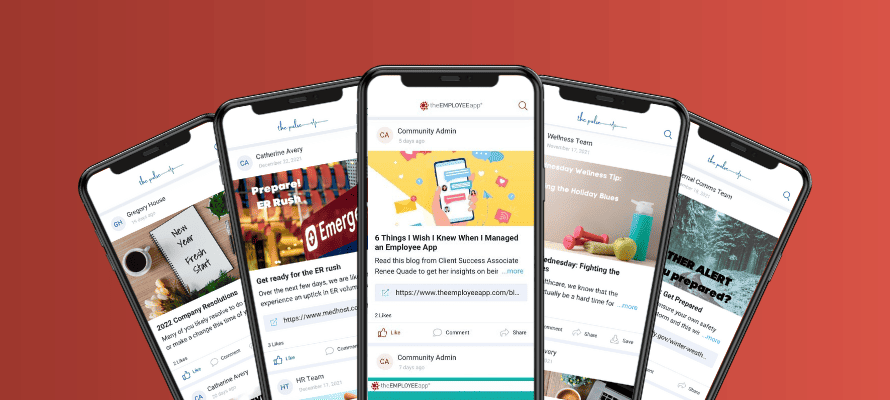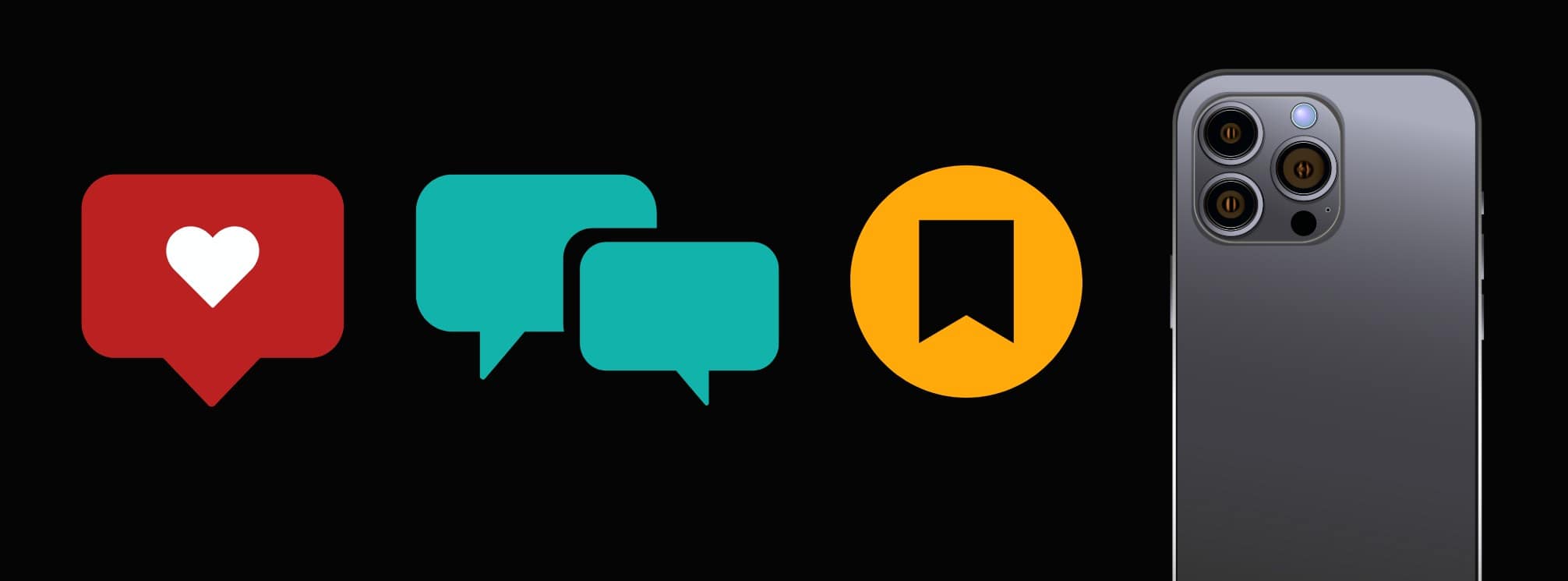
When you’re sharing content on a communication channel, it’s important to keep your goal in mind. Ask yourself, “Why am I sharing this content? What do I want my employees to say, think, feel, or do after engaging with it?” Then consider what internal comms metrics you’ll track to measure success. For many of us, increasing our content open rates are a big first step. After all, to get people to take action on communication, they need to click on it first. But how!? In this blog, we’ll talk about the importance of content titles for increasing mobile app engagement.
Before we talk tactics, let’s talk about what mobile app engagement is and why it matters.
App engagement is the actions taken within an application and on specific pieces of content. This can include liking and commenting on content, as well as sharing content, saving it, and clicking on posts.
Mobile app engagement metrics are very similar to what you might track for email communications. These actions help give us a sense of what resonates with employees and what matters most to them.
More advanced engagement metrics might include time spent on the application or on a piece of content as well as what actions did they take after clicking on certain posts.
Although looking at engagement metrics such as likes and comments in a vacuum are considered vanity metrics, that doesn’t mean that measuring mobile app engagement isn’t important.
In fact, these engagements are a great indicator of whether or not your communication channels and content strategy is effective. If your employees never click on a post or watch the video you’ve shared, they never have a chance to be activated. By that, we mean they never are given the information they need to take a desired action.
At the end of the day, we want our employees to do certain things, but it all starts with the click.

If you want to improve your mobile app engagement metrics, you have to be strategic. That means not just trying the same thing over and over, hoping for a new result.
We recommend, starting with your content titles. This is the first chance you have to get your audience’s attention. And email marketers focus on this all the time. Many will A/B test subject lines with the express purpose of increasing their email open rate.
You can do the same with your content by trying different strategies for writing your post content titles. Let’s talk about 5 different approaches you can take.
We’ve all heard of clickbait, right? This tactic is specifically designed to get people to click. The only problem with it is that clickbait often includes misleading your audience.
You obviously don’t want to do that with your employee communications. But that doesn’t mean we can’t learn from this enticement tactic. The key here is to drive some sense of urgency or excitement. Enticing titles are ones that show the value or the shock factor up front.
This strategy doesn’t really work for most operational or serious messages, but for recognition, contests, your newsletter, and other daily updates, this can be a great tactic to break through.
EXAMPLES:
Imagine that you’re a shift supervisor and you share shift notes at the end of each week on the app that recaps wins, challenges, recognition, and reminders from your in-person shift meetings. You can make a “clickbait” title and include some details in the caption so nothing important gets missed or left out.
| Type of Post Title | Example | Explanation |
|---|---|---|
| Plain | End-of-Week Recap | This post title is pretty vanilla, right? Your employees will need to be pretty motivated on a Friday to open this message. They might also assume there isn’t new information in your message if it’s just a “recap”. |
| Enticing | One of you won!
(Caption: Read the weekly recap for our focus for next week and to find out who the lucky winner is) |
Something like this works great for recognition posts where you tease that someone won a prize for their hard work. This will make everyone want to open the message to find out if it was them. |
| Enticing | 5 things you need to know before next week…👀 | A little bit of mystery goes a long way. Even if you’re reiterating 5 key takeaways from your meetings that week, this frames it as important, need-to-know information. |
This is a great gut check when drafting content for your employee app. Trust your instincts: if you think it’s boring, it’s boring. By asking yourself if you would be enticed to click on a message, you will automatically throw out half your title ideas.
And there are a few reasons why we just don’t click on certain posts:
Remember that you’re competing for your employees’ attention. You have to give them clear content, targeted to them, that seems worth their while.
That’s why we recommend writing content titles with a clear call to action (CTA). These are titles that make the why and the “what’s in it for me?” obvious right away,
And remember, employee app content is at its best when you support your title with a good caption and image that adds helpful context that screams, “Click me!”
EXAMPLES:
Let’s use that same scenario before. You’re a manager sharing a weekly recap with your direct reports.
| Type of Post Title | Example | Explanation |
|---|---|---|
| Plain | End-of-Week Recap | There is nothing specific in this title to tell employees why it’s important. It also doesn’t give them any action—should they read it or do something? It’s unclear. |
| Descriptive / Sharing the “Why” | Weekly Recap: Our big rocks, focus, and victories | This title is descriptive and tells the audience exactly what to expect. Maybe they forget what the focus was for the following week or they want to feel better about their week by reviewing their wins. In either case, you’re more likely to drive a click. |
| Call to Action / Urgency | Open Immediately: Weekly recap + action items | This is an example of using a call to action right in the title. And with the word choice, you drive a sense of urgency. |
Don’t overdo it, but sometimes using all caps for your title—or part of it—can visually attract the eye of someone scrolling through their news feed and improve mobile app engagement. But it can feel like being yelled at, so try not to USE CAPS ALL THE TIME FOR EVERYTHING.
See what I did there?
A little bit goes a long way.
EXAMPLE:
We love these for event reminders, contests, or trying to get employee feedback, as this can increase mobile app engagement. Say, you’re a regional field leader trying to encourage your team to register for the Town Hall that they now have access to thanks to the app!
| Type of Post Title | Example | Explanation |
|---|---|---|
| Plain | Heads Up: Last chance to register for the Town Hall | This title has a CTA and some urgency in it, which is great. But we can push it even further and make it stand out using CAPS. |
| Using CAPS | LAST CHANCE: Register for the Town Hall | This title emphasizes the urgency in the title, which will help catch the eye of employees scrolling through your app news feed. |
| Using CAPS | HEADS UP: Today’s the last day to register for the Town Hall | This title is a little more passive, but can still draw some attention. |
Unless you have a post to share that requires a more serious tone, an employee communications app is designed to be more fun than traditional comms channels. Use humor. Be more casual. And speak like you would to your team.
This is much more like how people talk on social media, but there’s a reason your internal channels don’t get the same kind of engagement. You’re a real person. Your audience is full of real people. Real people don’t talk like corporate jargon robots. So, embrace conversational language!
EXAMPLES:
Say you won a Best Place to Work Award (go you!). This is a super exciting message, so have fun getting the word out.
| Type of Post Title | Example | Explanation |
|---|---|---|
| Plain / Formal | We’ve been named a top 100 Best Place to Work! | While this is true and clearly shares what the message is, it’s just so formal! Your employees are going to assume that the content is as interesting as the title. If the post title is boring, they might not choose to engage further. |
| Fun / Informal | And the winner is… | This title uses both informal language, but also the enticement approach. Your employees are going to want to know who won and what. |
| Fun / Informal | WE DID IT! [Our Company] is a Best. Place. To. Work. 👏 | This title goes all out! There’s caps, exclamation marks, emojis, the whole 9. If you want employees to be excited about your award, you have to reflect that in the language you use when talking about it. |
[optin-monster slug=”pge4soguczgsqb7uozcq” followrules=”true”]
Okay, let’s be honest for a second. Who among us is an endless well of creativity? Certainly not me!
The truth is, it can be really hard to write exciting post titles every time. It’s even harder when the message is serious or repetitive (like a weekly newsletter).
I shamelessly lean on AI tools like Chat GPT when I need a little creativity boost or when I want to gut-check a post title or email subject line I’ve written.
Let me show you this in action.
I asked chat GPT to write me 5 subject lines that would be more engaging than “End of Week Recap” for an internal communication to field-based teams. Here are a few things it came up with:
These aren’t all winners, right? But I like the first one “Weekly Wins and Highlights: Celebrating our Field Team’s Success.”
But that’s why the trick with these AI tools is to give it specific prompts on tone and the type of details you want to be included. Here’s what happens when I ask it to iterate and give me 5 more options that are “more professional, with a call to action.”

Again, not perfect, but we’re getting the wheels turning. Maybe you like pieces of these that you can put together. Or maybe your original subject line is fine, you just want to add a little spice from one of these options.
But let’s try one more time, this time adding specific details about what the newsletter is about.
Hopefully, you see that these tools are only as good as your inputs, but they can go a long way toward helping you write more compelling app content titles. Or, at the very least, help give you a creativity boost!
Writing employee app content titles that activate and engage your employees doesn’t have to be difficult. Like with everything you communicate, just remember:
[optin-monster slug=”gqorn0natkqgyrtjvr6i” followrules=”true”]
Sydney Lauro is the Demand Generation Manager for theEMPLOYEEapp. Prior to joining the team at theEMPLOYEEapp, Sydney worked in internal communications for Chipotle Mexican Grill. She uses her internal comms expertise and passion for improving communication and the employee experience to create content and share best practices to help other communications professionals.